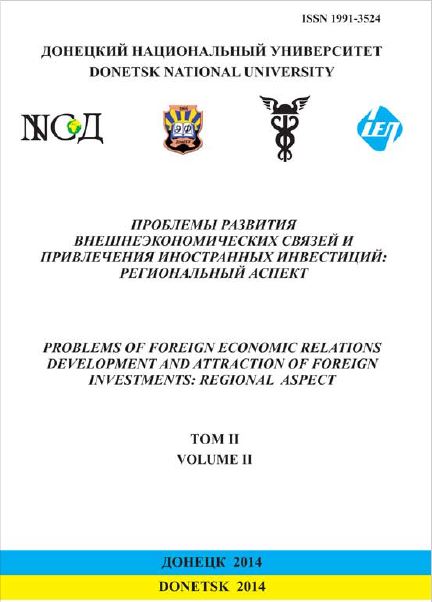Взаємодія інвестиційної привабливості та політичної стабільності.
Ключові слова:
інвестиційна привабливість, політична стабільність, прямі іноземні інвестиції, приплив ПІІ, відтік ПІІ, сальдоАнотація
У статті розглядається вплив прямих іноземних інвестицій на ряд економічних і політичних чинників. Проаналізовано взаємозв'язок між ПІІ та різними економічними та політичними показниками. Доведено, що країни з високим рівнем політичної системи, мають більш високі показники по відтоку ПІІ; в країнах з високим рівнем корупції уряду і низьким рівнем демократії спостерігається високий рівень припливу ПІІ. Доведено, що обсяги припливу ПІІ в економіку держави тісно взаємопов'язані з політичними факторами в країні. З практичної точки зору, ПІІ виступають певним індикатором, що визначає рівень довіри іноземних інвесторів до політичної та економічної системі держави. У деяких випадках рівень припливу ПІІ в країну ілюструє ступінь виконання передвиборних обіцянок чинним урядом держави. Прикладом може служити ситуація, коли завдяки залученим ПІІ для громадян країни відкриваються нові можливості працевлаштування і росте рівень соціально-економічного розвиток регіону-реципієнта даних ПІІ. Використовуваний автором підхід, який розглядає взаємозв'язок ПІІ з економічним і політичним рівнем розвитку держави спрямований на більш детальний аналіз взаємодії інвестиційної привабливості та політичної стабільності в державі.Посилання
Admati, Anat.&Pfleiderer, P. (2000). Forcing firms to talk: Financial disclosure and externalities, Review of Financial Studies, 13, 479-520.
Agmon, Tamir. & Lessard, D. R. (1977). Investor recognition of corporate international diversification, Journal of Finance, 32, 1049-1055.
Baker, Malcolm, Foley, C. Fritz. & Wurgler, J. (2009). Multinationals as arbitrageurs: The effect of stock market valuations on foreign direct investment, Review of Financial Studies, 22, 337-369.
Blonigen, Bruce A. (1997). Firm-specific assets and the link between exchange rates and foreign direct investment, American Economic Review, 87, 447-465.
Breusch, T. S. & Pagan, A. R. (1980). The Lagrange Multiplier test and its applications to model specification in econometrics, Review of Economic Studies, 47, 239-53.
Brune, N., Garrett, G., Guisinger, A. & Sorens, J. (2001). The political economy of capital account liberalization.
UCLA working paper, Los Angeles, CA.
Chan, Kitty K. & Gemayel, E. R. (2004). Risk instability and the pattern of foreign direct investment in the Middle East and North Africa region, IMF Working Paper WP/04/139, International Monetary Fund, Washington, D.C.
Demirguc-Kunt, Aslie. & Levine, R. (1996). Stock market development and financial intermediaries: Stylized facts, The World Bank Economic Review, 10, 291-321.
Denekamp, Johannes G. (1995). Intangible assets, internalization and foreign direct investment in manufacturing, Journal of International Business Studies, 26, 493-502.
Desai, Anand S., Dukas Stephen P. & Fatemi, A. M. (1996). The valuation effects of transnational acquisitions: Evidence from the Pacific Basin region, Advances in Pacific Basin Financial Markets, 2B, 223-235.
Desai, Mihir C., Foley, Fritz. & Hines, J. R. Jr. (2004). Foreign direct investment in a world of multiple taxes, Journal of Public Economics, 88, 2727-44.
Dewenter, Kathryn. (1995). Do exchange rate changes drive foreign direct investment?, Journal of Business, 68, 405-33.
Froot, Kenneth A. & Stein, J. C. (1991). Exchange rates and foreign direct investment: An imperfect capital markets approach, Quarterly Journal of Economics, 106, 1191-1217.
Fry, Maxwell J., Classens, Stijn, Burridge, Peter & Blanchet, M. C. (1995). Foreign direct investment, other capital flows, and current account deficits: What causes what?, World Bank Policy Research Paper 1527, World Bank, Washington, D.C.
Henry, Peter Blair. (2000a). Stock market liberalization, economic reform, and emerging market equity prices, Journal of Finance, 55, 529-64.
Henry, Peter Blair. (2000b). Do stock market liberalization cause investment booms?, Journal of Financial Economics, 58, 301-34.
Hymer, Stephen Herbert. (1976). The international operations of national firms: A study of direct foreign investment. Cambridge: MIT Press.
Johanson, Jan, & Vahlne, Jan-Erik. (1977). The internationalization process of the firm: A model of knowledge development, Journal of International Business Studies, 8, 23-32.
Kim, Wi Saeng, Esmeralda, Lyn & Zychowicz, E. J. (2005). Can stock market liberalization in emerging economies mitigate legal systems deficiencies?, Journal of Financial Research, 28, 421-37.
Klein, M. W. & Rosengren, E. S. (1994). The real exchange rate and foreign direct investment in the United States, Journal of International Economics, 36, 373-89.
La Porta, Rafael, Lopez-De-Silanes, Florencio, Shleifer, Andrei & Vishny, R. (1999). The quality of government, Journal of Law, Economics and Organization, 15, 222-79.
Lucas, Robert E. (1990). Why doesn’t capital flow from rich to poor countries? American Economic Review, 80, 92-6.
Markides, Constantinos C. & Ittner, C. D. (1994). Shareholder benefits from corporate international diversification: Evidence from U.S. international acquisitions Journal of International Business Studies, 25, 343-60.
Morck, Randall, & Young, Bernard. (1992). Internalization: An event study test, Journal of International Economics, 33, 41-56.
Singh, Harinder, & Jun, K. W. (1995). Some new evidence on determinants of foreign direct investment in developing countries, World Bank Policy Research Paper 1531, World Bank, Washington, D.C.
Strickland, Tomas H. & Hamaifar, Ghassem. (1990). Foreign direct investment: Evidence from capital market data, Global Finance Journal, 1, 153-162.
Wooldridge, Jeffrey M. (2002). Econometric analysis of cross-section and panel data, Cambridge: MIT Press. World Bank. (2002).
World Development Indicators, Washington, D.C.

